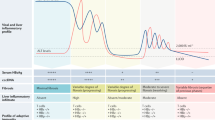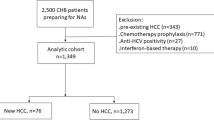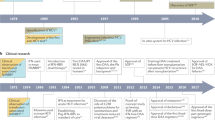Abstract
Liver disease has emerged as a major contributor to morbidity and mortality in patients with HIV infection. Hepatitis C virus (HCV) infection is a key element in the etiology of liver-associated injury in this population. Increased rates of fibrotic progression have been described and are mediated by alcohol use, the severity of immunosuppression, the use of antiretroviral therapy, and other factors. Large clinical trials have demonstrated the efficacy of treatment with pegylated interferon plus ribavirin and highlighted issues related to management of patients with HIV/HCV co-infection. Although treatment for HCV infection in this group remains a challenge, achievement of a sustained virologic response is feasible in approximately 35% of patients. Treatment must be individualized and attention must be paid to the potential for drug–drug interactions.
Key Points
-
Re-emergence of high-risk behaviors is leading to resurgence of HIV infection and co-infections, including hepatitis C virus (HCV)
-
End-stage liver disease exceeds AIDS as the leading cause of death among patients with HIV/HCV co-infection
-
Treatment with pegylated interferon plus ribavirin is superior to standard therapy with interferon plus ribavirin in patients with HIV/HCV co-infection
-
Selection of patients for treatment and the evaluation of antiretroviral regimens are crucial in this population
This is a preview of subscription content, access via your institution
Access options
Subscribe to this journal
Receive 12 print issues and online access
$209.00 per year
only $17.42 per issue
Buy this article
- Purchase on Springer Link
- Instant access to full article PDF
Prices may be subject to local taxes which are calculated during checkout



Similar content being viewed by others
References
CDC (2006) Epidemiology of HIV/AIDS—United States, 1981-2005. MMRW Morb Mortal Wkly Rep 55: 589–592
Salmon-Ceron D et al. (2005) Liver disease as a major cause of death among HIV infected patients: role of hepatitis C and B viruses and alcohol. J Hepatol 42: 799–805
Ragni MV et al. (2003) Survival of human immunodeficiency virus-infected liver transplant recipients. J Infect Dis 188: 1412–1420
Neff GW et al. (2005) Outcomes among patients with end-stage liver disease who are coinfected with HIV and hepatitis C virus. Clin Infect Dis 41: (Suppl): S50–S55
Benhamou Y et al. (1999) Liver fibrosis progression in human immunodeficiency virus and hepatitis C virus coinfected patients. The Multivirc Group. Hepatology 30: 1054–1058
Benhamou Y et al. (2001) Factors affecting liver fibrosis in human immunodeficiency virus- and hepatitis C virus-coinfected patients: impact of protease inhibitor therapy. Hepatology 34: 283–287
Graham CS et al. (2001) Influence of human immunodeficiency virus infection on the course of hepatitis C virus infection: a meta-analysis. Clin Infect Dis 33: 562–569
Chung RT et al. (2004) Peginterferon alfa-2a plus ribavirin versus interferon alfa-2a plus ribavirin for chronic hepatitis C in HIV-coinfected persons. N Engl J Med 351: 451–459
Torriani FJ et al. (2004) Peginterferon alfa-2a plus ribavirin for chronic hepatitis C virus infection in HIV-infected patients. N Engl J Med 351: 438–450
Carrat F et al. (2004) Pegylated interferon alfa-2b vs standard interferon alfa-2b, plus ribavirin, for chronic hepatitis C in HIV-infected patients: a randomized controlled trial. JAMA 292: 2839–2848
Laguno M et al. (2004) Peginterferon alfa-2b plus ribavirin compared with interferon alfa-2b plus ribavirin for treatment of HIV/HCV co-infected patients. AIDS 18: F27–F36
Cargnel A et al. (2005) Open, randomized, multicentre Italian trial on PEG-IFN plus ribavirin versus PEG-IFN monotherapy for chronic hepatitis C in HIV-coinfected patients on HAART. Antivir Ther 10: 309–317
Fleming CA et al. (2003) Hepatitis C virus and human immunodeficiency virus coinfection in an urban population: low eligibility for interferon treatment. Clin Infect Dis 36: 97–100
Backmund M et al. (2004) Infrequent reinfection after successful treatment for hepatitis C virus infection in injection drug users. Clin Infect Dis 39: 1540–1543
Sim SM et al. (1998) Effect of ribavirin on zidovudine efficacy and toxicity in vitro: a concentration-dependent interaction. AIDS Res Hum Retroviruses 14: 1661–1667
Fleischer R et al. (2004) Nucleoside analogues and mitochondrial toxicity. Clin Infect Dis 38: e79–e80
Alvarez D et al. (2006) Zidovudine use but not weight-based ribavirin dosing impacts anaemia during HCV treatment in HIV-infected persons. J Viral Hepat 13: 683–689
Sherman KE et al. (2002) Comparison of methodologies for quantification of hepatitis C virus (HCV) RNA in patients coinfected with HCV and human immunodeficiency virus. Clin Infect Dis 35: 482–487
Bonacini M et al. (1999) Patients co-infected with human immunodeficiency virus and hepatitis C virus demonstrate higher levels of hepatic HCV RNA. J Viral Hepatol 6: 203–208
Sherman KE et al. (2005) Viral kinetics in hepatitis C or hepatitis C/human immunodeficiency virus-infected patients. Gastroenterology 128: 313–327
Soriano V et al. (2004) Hepatitis C virus (HCV) relapses after anti-HCV therapy are more frequent in HIV-infected patients. AIDS Res Hum Retroviruses 20: 351–353
Sulkowski MS et al. (2002) Hepatotoxicity associated with nevirapine or efavirenz-containing antiretroviral therapy: role of hepatitis C and B infections. Hepatology 35: 182–189
Melvin DC et al. (2000) The impact of co-infection with hepatitis C virus and HIV on the tolerability of antiretroviral therapy. AIDS 14: 463–465
Qurishi N et al. (2003) Effect of antiretroviral therapy on liver-related mortality in patients with HIV and hepatitis C virus coinfection. Lancet 362: 1708–1713
Author information
Authors and Affiliations
Corresponding author
Ethics declarations
Competing interests
Kenneth E Sherman receives research support from Abbott, Intermune, Idenix, Roche, SciClone Pharmaceuticals, and Schering-Plough. He belongs to the speaker bureau of Roche, Schering-Plough and SciClone Pharmaceuticals, and is a consultant for these three companies and BMS.
Rights and permissions
About this article
Cite this article
Sherman, K. New paradigms in the management of hepatitis C virus co-infections. Nat Rev Gastroenterol Hepatol 4 (Suppl 1), S10–S16 (2007). https://doi.org/10.1038/ncpgasthep0692
Received:
Accepted:
Issue Date:
DOI: https://doi.org/10.1038/ncpgasthep0692



